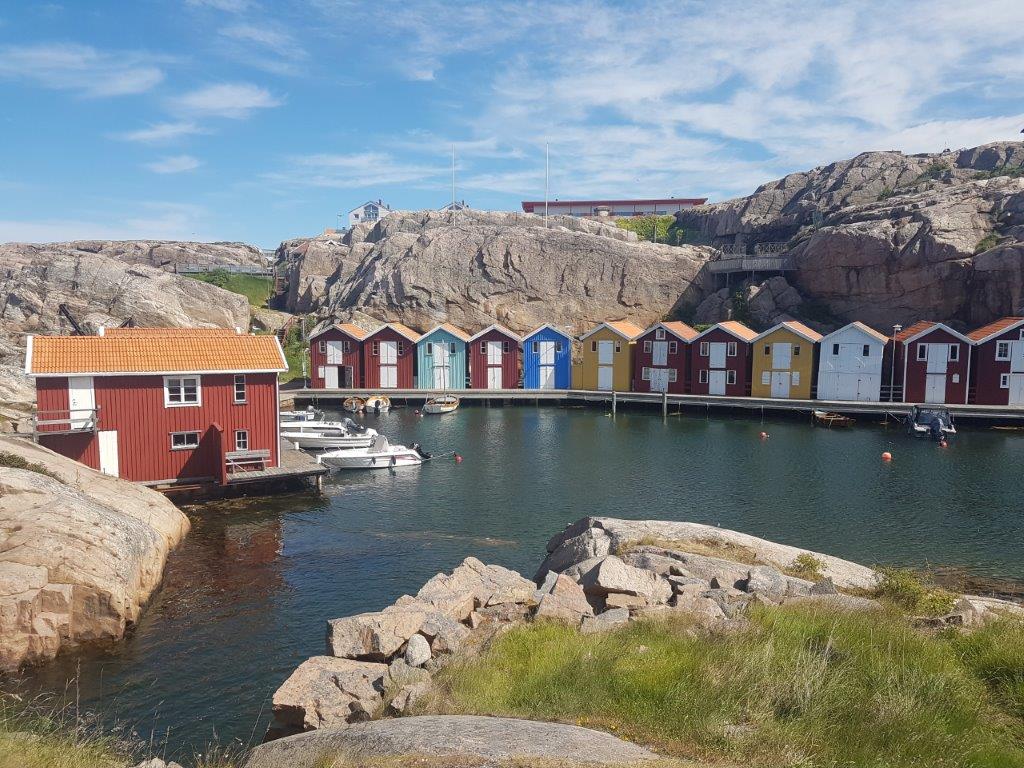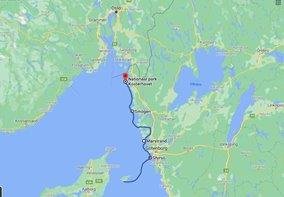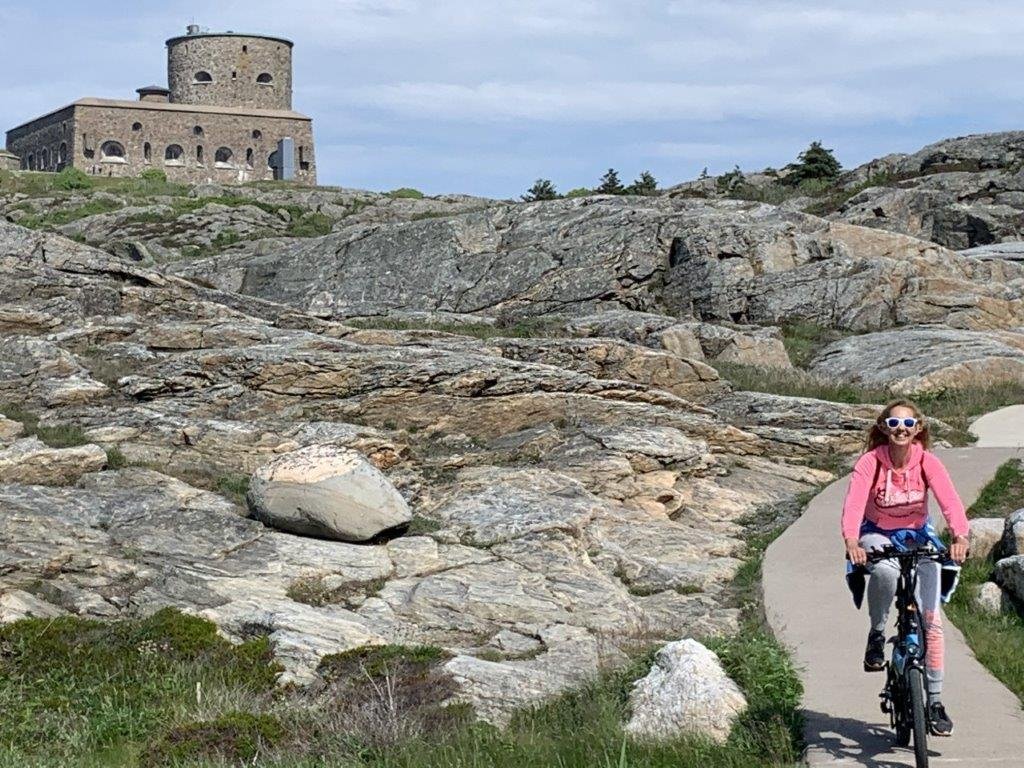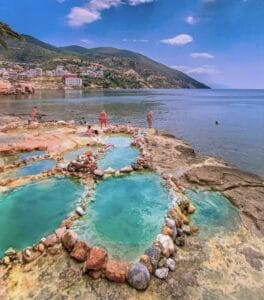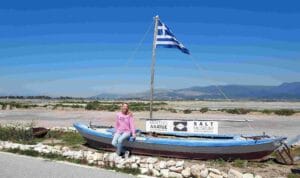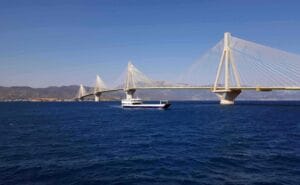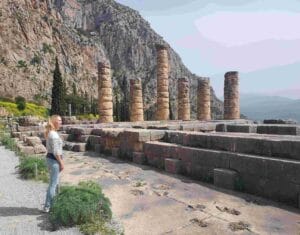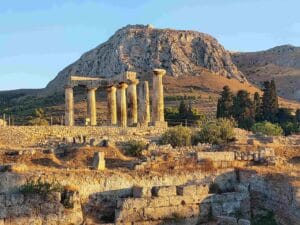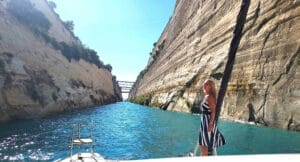Did you know about the Göteborg Archipelago? We didn’t, so when we read about it, to our surprise there were beautiful islands in front of the coast of Göteborg! The scenery is completely different from the 2 weeks we sailed in Denmark. In Denmark were rolling green hills with yellow flower fields, and in the background the red wooden Danish houses. When we entered the waters in the Göteborg Archipel, the scenery changed into rock walls and many small islands with pastel blue, green, yellow and white Swedish wooden houses. The islands In Sweden situated so close to each other, a jumble of ferry services were crossing in front and behind our boat all the time. A very lively atmosphere that we loved!
We visited 4 islands at this North west coast of Sweden.
First we visited the island of Styrsö where we explored the rocky island. Cycling over the steep hills with the colorful Swedish houses. At the coast, we saw lots of people swimming, jumping from the rocks, because water temperature turned out to be 21,5 ℃ in June here! When we came on top of the island during sunset (22.30h), we had a 360 degree view over the Archipel with over 200 small islands surrounding us. It was beautiful!
After Styrsö we sailed to Marstrand, and the sailing trip alone was worthwhile! Sailing next to all the little islands, sometimes small passages between 2 islands, you could see the Swedish houses above you on the granite rocks. Because people live so close to the boats passing by, they sometimes waved at us or shouted ‘Beautiful boat’, because they don’t get to see many catamarans in this area of Northern Europe (in the 6 weeks that we started our journey, we have seen 2 other catamarans!).
Marstrand is an elegant island: well maintained Swedish colorful houses and fancy restaurants at the boulevard. Now we understand the royal family spends their summerholidays here! In July there is also a famous Sailing Regatta and the quiet city turns into the Swedish Sailing Capital. Marstrand has an old royal castle (Carlstens Fortress) and beautiful society houses from the time king Oscar II owned the island. That’s way the atmosphere is still grand.
We read about Smögen, one of the most photographed islands in Sweden, because of the many colorful fisherhouses and cosy swimming places between the granite rocks. On one hand the island is a quiet traditional fisher village. But on the other hand, the center is really busy with visitors from all over Sweden. The harbor is in this center and is something that we had not seen before: a 1 kilometer ‘street’ where people moor their boats at a long wooden boardwalk. So did we as well and immediately we were in the middle of all the action! We ate a fresh shrimp salad at a small fish shop and we visited a few shops on the boardwalk. At the shores of the island, we enjoyed the quiet fishersvillages and sitting in the sun on the granite rocks. In the evening we watched from our boat all the dressed up young people walking the wooden boardwalk up and down like a catwalk 😉.
Koster was the last island we visited in Sweden. It’s at the top of the Northwest coast of Sweden, close to Norway. Koster is no part of the Archipelago, but has a status of its own. It’s a National Park. Koster consists of 2 islands, North Koster and South Koster. The islands have only 300 habitants and 900 ha land, but the National Park is the biggest National Park in Sweden: it is a so called Maritime Park with 39.000 protected ha of sea area. The Koster fjord has a coral reef (the only one in Sweden) and has lots of fish and birds. Two fun facts: because of all the fish, already in the 17th century Koster exported lobster to….. the Netherlands! Funfact nr 2: the waters around Koster island are more than 200 meter deep, which is by far the deepest water we have encountered in 6 weeks time! Our measuring equipment onboard ‘only’ get to minus 150 meters, so it gave an error trying to measure the 238 meters we sailed over!
These Koster islands were totally different from the lively Smögen where we stayed the day before, this was a quiet recreational National Park. That’s what we loved about the North West coast of Sweden: a lot of variety in landscape!
